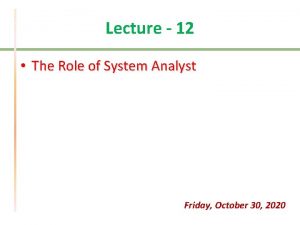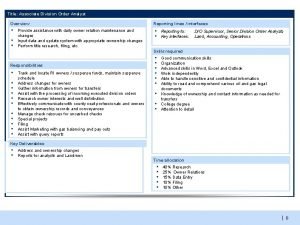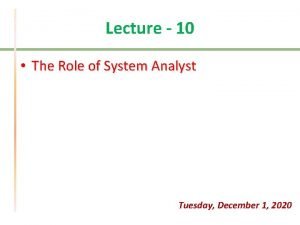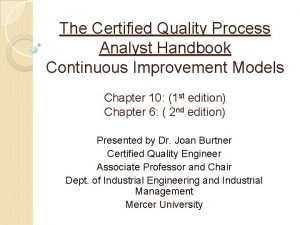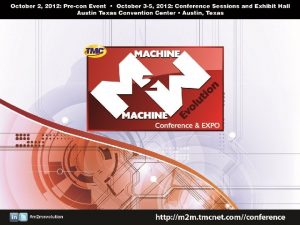Assuming the Role of the Systems Analyst Systems










































- Slides: 42

Assuming the Role of the Systems Analyst Systems Analysis and Design, 7 e Kendall & Kendall © 2008 Pearson Prentice Hall 1

Learning Objectives • Recall the basic types of computer-based systems that a systems analyst needs to address • Understand how users working in context with new technologies change the dynamics of a system • Realize what the many roles of the systems analyst are • Know the steps of the SDLC as they relate to HCI and how to apply them to a real system • Understand what CASE tools are and how they help a systems analyst • Explore other methodologies such as object-oriented systems design and prototyping Kendall & Kendall 1 -2

Information – A Key Resource • Fuels business and can be the critical factor in determining the success or failure of a business • Needs to be managed correctly • Managing computer-generated information differs from handling manually produced data Kendall & Kendall 1 -3

Major Topics • Fundamentals of different kinds of information systems • Roles of systems analysts • Phases in the systems development life cycle as they relate to Human-Computer Interaction (HCI) factors • Computer-Aided Software Engineering (CASE) tools Kendall & Kendall 1 -4

Systems Analysts Recommend, Design, and Maintain Many Types of Systems for Users • • • Kendall & Kendall Transaction Processing Systems (TPS) Office Automation Systems (OAS) Knowledge Work Systems (KWS) Management Information Systems (MIS) Decision Support Systems (DSS) Expert Systems (ES) Executive Support Systems (ESS) Group Decision Support Systems (GDSS) Computer-Supported Collaborative Work Systems (CSCWS) 1 -5

Strategic Level A systems analyst may be involved with any or all of these systems at each organization level Higher Level Knowledge Level Operational Level Kendall & Kendall 1 -6

Operational Level • Transaction Processing System (TPS) • Process large amounts of data for routine business transactions • Boundary-spanning • Support the day-to-day operations of the company • Examples: Payroll Processing, Inventory Management Kendall & Kendall 1 -7

Knowledge Level • Office Automation System (OAS) • Supports data workers who share information, but do not usually create new knowledge • Examples: Word processing, Spreadsheets, Desktop publishing, Electronic scheduling, Communication through voice mail, Email, Video conferencing • Knowledge Work System (KWS) • Supports professional workers such as scientists, engineers, and doctors • Examples: computer-aided design systems, virtual reality systems, investment workstations Kendall & Kendall 1 -8

Higher Level • Management Information System (MIS) • Support a broad spectrum of organizational tasks including decision analysis and decision making • Examples: profit margin by sales region, expenses vs. budgets • Decision Support System (DSS) • Aids decision makers in the making of decisions • Examples: financial planning with what-if analysis, budgeting with modeling • Expert System (ES) • Captures and uses the knowledge of an expert for solving a particular problem which leads to a conclusion or recommendation • Examples: MYCIN, XCON Kendall & Kendall 1 -9

Strategic Level • Executive Support System (ESS) • Helps executives to make unstructured strategic decisions in an informed way • Examples: drill-down analysis, status access • Group Decision Support System (GDSS) • Permit group members to interact with electronic support • Examples: email, Lotus Notes • Computer-Supported Collaborative Work System (CSCWS) • CDCWS is a more general term of GDSS • May include software support called “groupware” for team collaboration via network computers • Example: video conferencing, Web survey system Kendall & Kendall 1 -10

Integrating New Technologies into Traditional Systems • • • Ecommerce and Web Systems Enterprise Resource Planning Systems Wireless Systems Open Source Software Need for Systems Analysis and Design Kendall & Kendall 1 -11

Figure 1. 2 Systems analysts need to be aware that integrating technologies affects all types of systems Kendall & Kendall 1 -12

Ecommerce and Web Systems • Benefits • Increasing user awareness of the availability of a service, product, industry, person, or group • The possibility of 24 -hour access for users • Improving the usefulness and usability of interface design • Creating a system that can extend globally rather than remain local, thus reaching people in remote locations without worry of the time zone in which they are located Kendall & Kendall 1 -13

Enterprise Resource Planning Systems (ERP) • Performs integration of many information systems existing on different management levels and within different functions • Example: SAP, Oracle Kendall & Kendall 1 -14

Wireless Systems • System analyst may be asked to design standard or wireless communication networks that integrate voice, video and email into organizational intranets or industry extranets • System analyst may also be asked to develop intelligent agents • Example: Microsoft's new software based on Bayesian statistics • Wireless communication is referred as mcommerce (mobile commerce) Kendall & Kendall 1 -15

Open Source Software • An alternative of traditional software development where proprietary code is hidden from the users • Open source software is free to distribute, share and modify • Characterized as a philosophy rather than simply the process of creating new software • Example: Linux Operating System, Apache Web Server, Mozilla Firefox Web browser Kendall & Kendall 1 -16

Need for Systems Analysis and Design • Installing a system without proper planning leads to great user dissatisfaction and frequently causes the system to fall into disuse • Lends structure to the analysis and design of information systems • A series of processes systematically undertaken to improve a business through the use of computerized information systems Kendall & Kendall 1 -17

Roles of the Systems Analyst • The analyst must be able to work with people of all descriptions and be experienced in working with computers • Three primary roles: • Consultant • Supporting Expert • Agent of change Kendall & Kendall 1 -18

Qualities of the Systems Analyst • • Problem solver Communicator Strong personal and professional ethics Self-disciplined and self-motivated Kendall & Kendall 1 -19

Systems Development Life Cycle (SDLC) • The systems development life cycle is a phased approach to solving business problems • Developed through the use of a specific cycle of analyst and user activities • Each phase has unique user activities Kendall & Kendall 1 -20

Figure 1. 3 The seven phases of the systems development life cycle Kendall & Kendall 1 -21

Incorporating Human-Computer Interaction (HCI) Considerations • The demand for analysts who are capable of incorporating HCI into the systems development process keeps increasing, as companies begin to realize that the quality of systems and the quality of work life can be improved by taking a human-centered approach at the outset of a project Kendall & Kendall 1 -22

Phase 1: Identifying Problems, Opportunities, and Objectives • Activity: • Interviewing user management • Summarizing the knowledge obtained • Estimating the scope of the project • Documenting the results • Output: • Feasibility report containing problem definition and objective summaries from which management can make a decision on whether to proceed with the proposed project Kendall & Kendall 1 -23

Phase 2: Determining Human Information Requirements • Activity: • Interviewing • Sampling and investing hard data • Questionnaires • Observe the decision maker’s behavior and environment • Prototyping • Learn the who, what, where, when, how, and why of the current system • Output: • Analyst understands how users accomplish their work when interacting with a computer; and begin to know how to make the new system more useful and usable. The analyst should also know the business functions and have complete information on the people, goals, data and procedure involved Kendall & Kendall 1 -24

Phase 3: Analyzing System Needs • Activity: • Create data flow diagrams • Complete the data dictionary • Analyze the structured decisions made • Prepare and present the system proposal • Output: • Recommendation on what, if anything, should be done Kendall & Kendall 1 -25

Phase 4: Designing the Recommended System • Activity: • • • Design Design procedures for data entry the human-computer interface system controls files and/or database backup procedures • Output • Model of the actual system Kendall & Kendall 1 -26

Phase 5: Developing and Documenting Software • Activity: • System analyst works with programmers to develop any original software • Works with users to develop effective documentation • Programmers design, code, and remove syntactical errors from computer programs • Document software with help files, procedure manuals, and Web sites with Frequently Asked Questions • Output: • Computer programs • System documentation Kendall & Kendall 1 -27

Phase 6: Testing and Maintaining the System • Activity: • Test the information system • System maintenance • Maintenance documentation • Output: • Problems, if any • Updated programs • Documentation Kendall & Kendall 1 -28

Phase 7: Implementing and Evaluating the System • Activity: • Train users • Analyst plans smooth conversion from old system to new system • Review and evaluate system • Output: • Trained personnel • Installed system Kendall & Kendall 1 -29

Figure 1. 4 Some researchers estimate that the amount of time spent on systems maintenance may be as much as 60 percent of the total time spent on systems projects Kendall & Kendall 1 -30

The Impact of Maintenance • Maintenance is performed for two reasons • Removing software errors, and • Enhancing existing software • Reasons for enhancing existing software • users request additional features • business changes over time • hardware and software change Kendall & Kendall 1 -31

The Impact of Maintenance • Over time the cost of continued maintenance will be greater than that of creating an entirely new system. At that point it becomes more feasible to perform a new systems study Kendall & Kendall 1 -32

Figure 1. 5 Resource consumption over the system life Kendall & Kendall 1 -33

Approaches to Structured Analysis and Design and to the Systems Development Life Cycle • Traditional systems development life cycle • CASE systems development life cycle • Object-Oriented Systems Analysis and Design Kendall & Kendall 1 -34

Case Tools • CASE tools are productivity tools for systems analysts that have been created explicitly to improve their routine work through the use of automated support • Reasons for using CASE tools • • Kendall & Kendall Increasing Analyst Productivity Improving Analyst-User Communication Integrating Life Cycle Activities Accurately Assessing Maintenance Changes 1 -35

Case Tool Classifications • Upper CASE tools perform analysis and design • Lower CASE tools generate programs from CASE design • Integrated CASE tools perform both upper and lower CASE functions Kendall & Kendall 1 -36

Upper CASE Tools • Create and modify the system design • Help in modeling organizational requirements and defining system boundaries • Can also support prototyping of screen and report designs Kendall & Kendall 1 -37

Lower CASE Tools • Lower CASE tools generate computer source code from the CASE design • Source code is usually generated in several languages Kendall & Kendall 1 -38

Figure 1. 7 Traditional versus CASE systems development life cycle Kendall & Kendall 1 -39

Object-Oriented Systems Analysis and Design • Alternate approach to the structured approach of the SDLC that is intended to facilitate the development of systems that must change rapidly in response to dynamic business environments • Analysis is performed on a small part of the system followed by design and implementation. The cycle repeats with analysis, design and implementation of the next part and this repeats until the project is complete Kendall & Kendall 1 -40

Alternate Approaches to Structured Analysis and Design and to the Systems Development Life Cycle • Agile approach • Prototyping • ETHICS • Project champion • Soft Systems Methodology • Multiview Kendall & Kendall 1 -41

Summary • Information is a key resource • Systems analysts deal with many types of information systems • Integration of traditional systems with new technologies • Roles and qualities of the systems analyst • The systems Development Life Cycle • CASE tools • Alternatives to structured analysis and design and to the SDLC Kendall & Kendall 1 -42
 Explain the multifaceted role of system analyst
Explain the multifaceted role of system analyst Role of system analyst
Role of system analyst Systems analyst career progression
Systems analyst career progression Azure worker role
Azure worker role Symbolischer interaktionismus krappmann
Symbolischer interaktionismus krappmann Statuses and their related roles determine
Statuses and their related roles determine Assuming a half life of 1599 years
Assuming a half life of 1599 years Every class has
Every class has In a prony brake dynamometer mcq
In a prony brake dynamometer mcq Assuming a 1 kb page size
Assuming a 1 kb page size Tami teitter
Tami teitter Division order analyst
Division order analyst Business analysis competencies
Business analysis competencies Flowchart tool
Flowchart tool Megaputer intelligence
Megaputer intelligence Subsurface analyst
Subsurface analyst Social finance analyst programme
Social finance analyst programme Shell lubeanalyst
Shell lubeanalyst Visible analyst
Visible analyst Analyst hierarchy
Analyst hierarchy Giac certified intrusion analyst
Giac certified intrusion analyst Esri community analyst
Esri community analyst Talent analyst emsi
Talent analyst emsi Business analysis case study
Business analysis case study T shaped business analyst
T shaped business analyst Interpersonal skills of system analyst
Interpersonal skills of system analyst Spotfre
Spotfre Technical skills of system analyst
Technical skills of system analyst Cost analyst
Cost analyst Cost analyst
Cost analyst Tony a data analyst for a major casino
Tony a data analyst for a major casino Business acceptance analyst
Business acceptance analyst Ifs business analyst
Ifs business analyst Mzmine
Mzmine Visible analyst case tool
Visible analyst case tool Effas certified esg analyst
Effas certified esg analyst The collection analyst
The collection analyst Poly analyst
Poly analyst Poly analyst
Poly analyst Ergoanalyst
Ergoanalyst Certified quality process analyst
Certified quality process analyst Modflow analyst
Modflow analyst Gms groundwater modeling
Gms groundwater modeling
